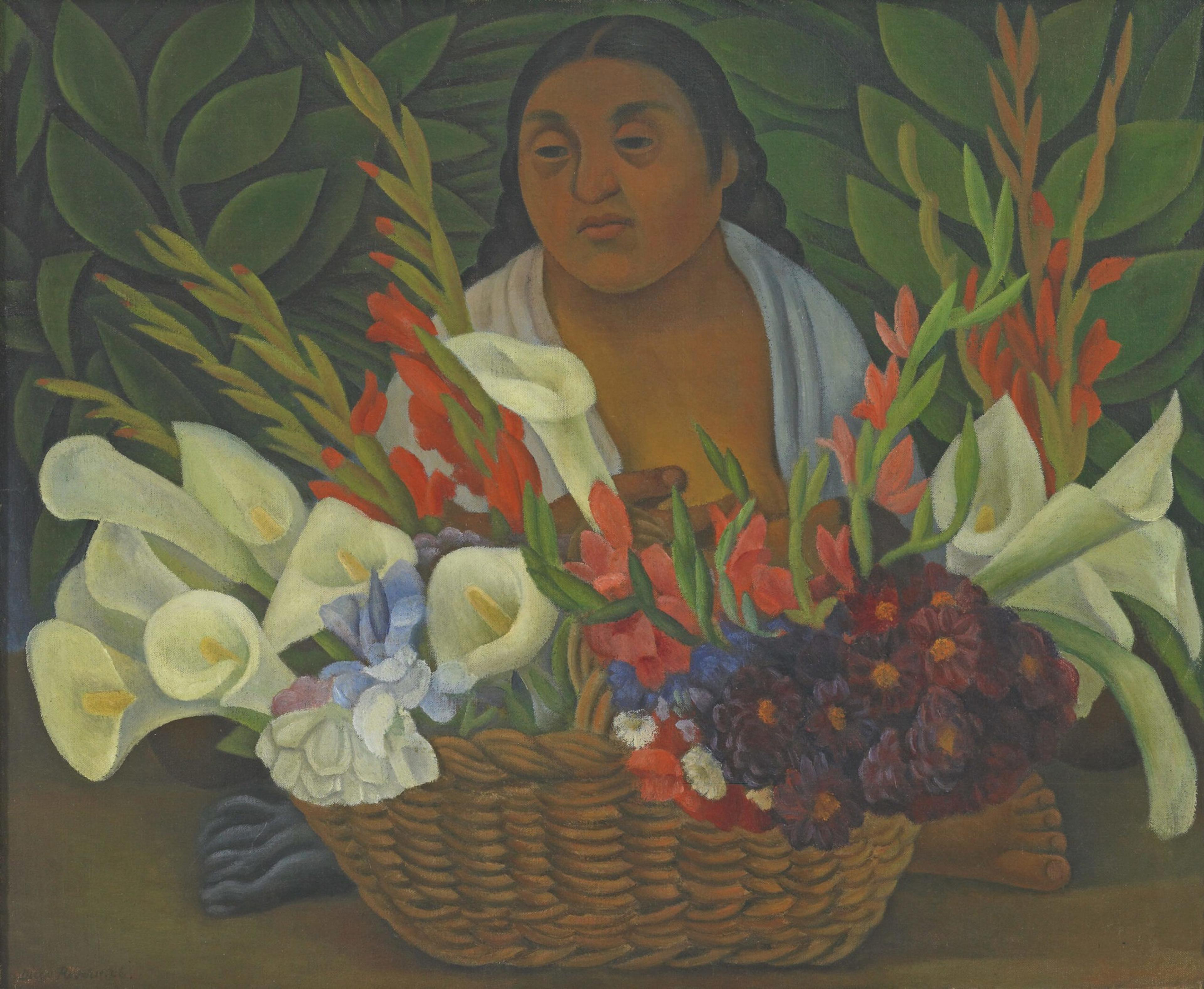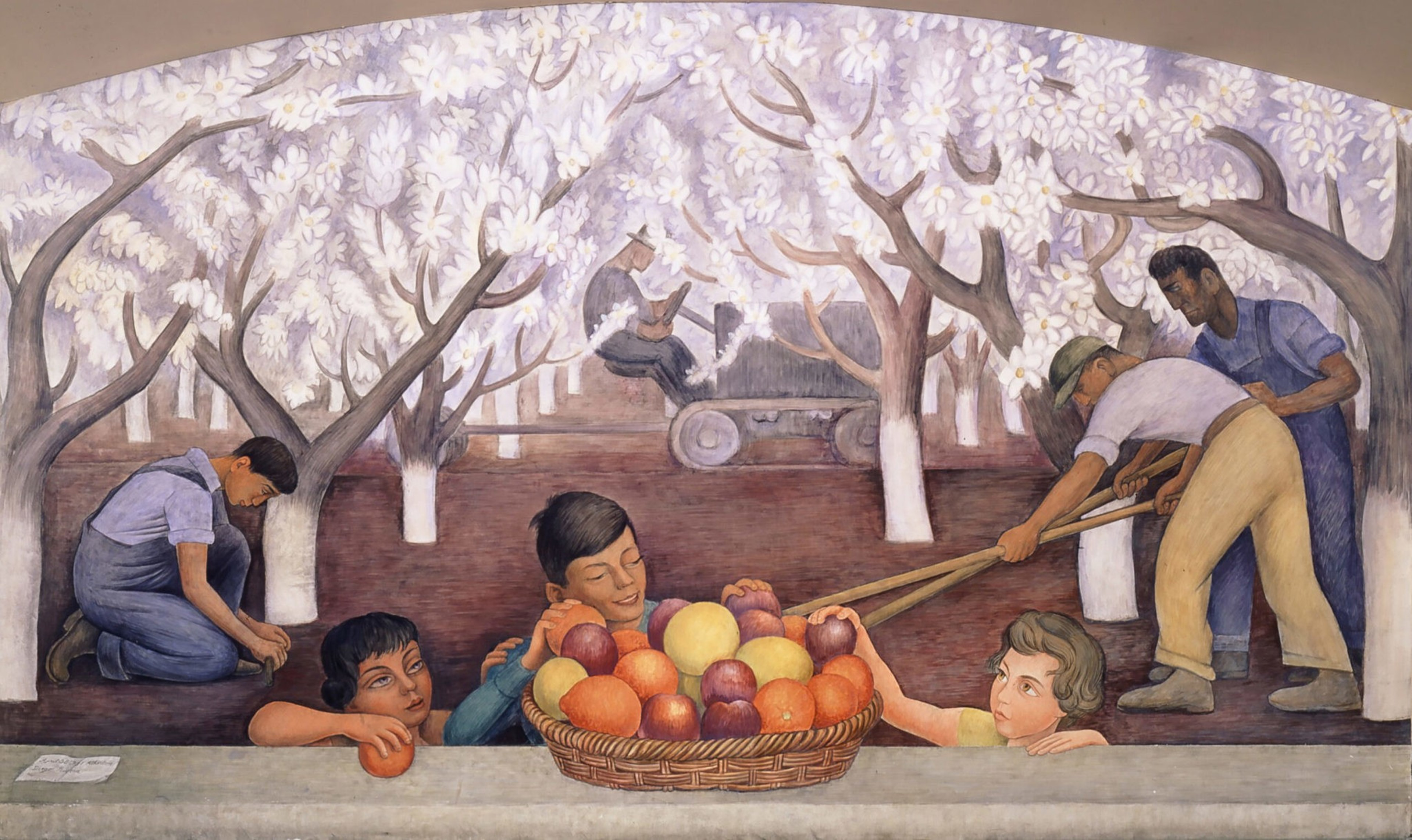In class struggle, the poor and working class are often defined as faceless, homogenous hordes. For an example, look no further than the way a certain, recent president talked about the United States’ migrant workforce. Whether in small paintings or massive murals, Diego Rivera (1886-1957) sought to depict the humanity of American workers across the continent.
This is the focus of the new exhibition Diego Rivera’s America, at the San Francisco Museum of Modern Art, the most in-depth examination of the Mexican artist’s work in over two decades. The show is a mix of the murals Rivera produced—which were often laden with overt Communist messaging meant to celebrate workers and educate the public on class consciousness—and his subtler easel paintings showing scenes of everyday life, which make a case for the personal as political, too.
Rivera defined America broadly as “the territory included between two ice barriers of the two poles.” Accordingly, many of the paintings here chronicle his travels throughout Mexico and the United States, documenting the communities he passed through. Rather than follow a chronological progression, however, the 100-plus artworks on view—many of them being exhibited publicly for the first time—are spread throughout 10 themed galleries, from “An Allegory for Mexico” to Rivera’s “Return to San Francisco.” These include paintings, murals, process sketches, book and magazine illustrations, and even theater costumes Rivera designed.
Rivera began painting in the Americas in the 1920s, where he returned after spending the prior 12 years in Paris, waiting out the Mexican Revolution (1910-1920). Some of these paintings show groups of people gathering for social events, like “Dance in Tehuantepec” (1928), while the vast majority are stylized portraits of individuals, many of which are women. “Flower Seller” (1926), which shows a woman nursing her baby behind the foliage of the goods she’s hawking, is particularly touching and a prime example of how Rivera blended politics into his representations of everyday people.

Rivera’s paintings might appear to be less political than his murals since they were made to succeed more easily in a collector market. But by often showing their subjects in the context of their work, the portraits emphasize class as definitive of one’s role in society. Even pictures not expressly of people at work, like “Seated Girls” (1928), which shows two small children—one wearing shoes and reading aloud from a book and the other barefoot, listening—present a measure of class commentary.
California’s long history of migrant labor is also reflected in the exhibition, mostly in some of Rivera’s most seminal murals. Rivera first came to San Francisco in 1930 to produce the mural “Allegory of California.” It was completed in 1931 at the San Francisco stock exchange (now the City Club of San Francisco) and presented here as a nearly life-sized video projection, with actors flitting in and out to provide a sense of scale. The mural shows a Mother Earth-like woman holding an assortment of laborers to her bosom with one hand, a cornucopia of fruits and vegetables in the other. That Rivera placed this image in a space built for the perpetuation of capitalist wealth was itself a political act, reminding the traders in the stock exchange who they had to thank for the profits they reaped.
One of two murals physically present in the exhibition is the smaller “Still Life and Blossoming Almond Trees” (1931). Originally painted for the home of Sigmund Stern in Atherton, it now resides in UC Berkeley’s Stern Hall dormitory. Here is a scene of Bay Area agriculture easily recognizable to this day: A group of men tending to a grove of almond trees. A multi-racial trio of children in the foreground pick from a basket of fruit, which strikes me as a metaphor for the fruits of labor resting in the hands of future generations.

The second mural physically present at SFMOMA, on loan from San Francisco City College, is on view free of charge on the museum’s ground floor. The massive, 22’ x 74’ piece is truly epic. It is titled “The Marriage of the Artistic Expression of the North and of the South on This Continent”—often referred to simply as “Pan American Unity”—and shows scenes of labor throughout the continental American West, from indigenous stone carvers to white lumberjacks and seemingly everything in between. The mural was created as the headlining attraction of the Golden Gate International Exposition on Treasure Island, where Rivera produced the mural before a live audience over the course of the fair—itself a performative act of labor.
Painting has a long history of wealthy patrons commissioning portraits of themselves, governments commissioning historical scenes, and the church as a major benefactor of allegorical murals. One thing Rivera’s work does—direct political commentary aside—is make the overarching statement that everyone deserves to be seen, every story deserves to be told, perhaps especially for those who can’t afford to commission that telling. By witnessing the continent through the lens of a diverse portrait of the working class, Rivera elevated his subjects as individuals. I was struck by just how contemporary this commentary was and how little we, as a continent divided regionally, as well as across class and race, seem to have moved toward unity in the time since Rivera painted America.
Diego Rivera’s America (opens in new tab) is on view at SFMOMA through Jan. 2, 2023, from 10 a.m. to 5 p.m. Fridays through Tuesdays and 1 to 8 p.m. Thursdays. Tickets are $19-$25. sfmoma.org (opens in new tab)
